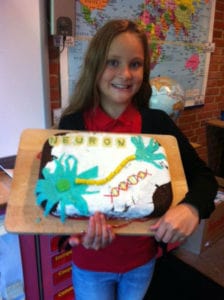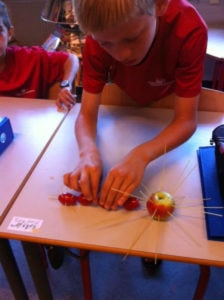 A PYP teacher in Denmark has created a whole unit on the concept of the growth mindset. She tells IB World about the changes she has seen as a result
A PYP teacher in Denmark has created a whole unit on the concept of the growth mindset. She tells IB World about the changes she has seen as a result
Almost every IB teacher has heard about the concept of the growth mindset, but how many are putting it into action in the classroom?
The growth mindset describes the underlying beliefs people have about learning and intelligence. According to author Carol Dweck, students with a growth mindset believe that their most basic abilities can be developed through hard work, persistence and dedication – they feel encouraged to take risks and not cower away from failure, but instead see it as necessary to success.
On the other hand, students with a fixed mindset believe qualities like intelligence or talent are unchangeable traits and are likely to avoid developing them. They shy away from challenges to ultimately avoid failure.
 Teacher practice massively impacts student mindset: in other words, it makes a significant difference if a teacher praises a student for ‘what’ they have noticed about the student’s learning and capabilities, as opposed to praising them for their intelligence. Feedback can either encourage a child to rise to a challenge or look for an easy way out, as PYP teacher Mihaela Morello, at Esbjerg International School, in Denmark, has discovered.
Teacher practice massively impacts student mindset: in other words, it makes a significant difference if a teacher praises a student for ‘what’ they have noticed about the student’s learning and capabilities, as opposed to praising them for their intelligence. Feedback can either encourage a child to rise to a challenge or look for an easy way out, as PYP teacher Mihaela Morello, at Esbjerg International School, in Denmark, has discovered.
Last year, Morello created a unit based on the growth mindset and it transformed student learning. She shares her experience with IB World magazine:
“Over the years, I’ve observed how my enthusiasm for mathematics has been transmitted to students. But, through reading about the concept of building a growth mindset, I have learned that such attitudes and skills need to be explicitly taught sometimes.
“I came across Professor Jo Boaler’s youcubed website. She discusses building a growth mindset in mathematics and her research demonstrates how this can help improve students’ learning.
“Boaler led me to read about Carol Dweck’s work. I decided that introducing my students to growth mindset research might offer them lifelong dispositions they can use throughout their school and life career.
School changes a student’s mindset from the moment they start. I’ve observed my own children throughout their school career from kindergarten to university. The enthusiasm of the first day in kindergarten was never to be found again.
 “Over time, the feeling of school being a set of rules and learning that others have planned for you, the need to have the correct answer, and the obligation to pass exams in order to succeed, creates a fixed mindset. This has become a school survival kit or, better put, a way for students to fake their way through school.
“Over time, the feeling of school being a set of rules and learning that others have planned for you, the need to have the correct answer, and the obligation to pass exams in order to succeed, creates a fixed mindset. This has become a school survival kit or, better put, a way for students to fake their way through school.
“Last year was the first time I created a whole unit on the concept of the growth mindset.
“The unit was under the transdisciplinary theme of ‘How We Express Ourselves’. It focused on the ways we discover and express ideas, and the ways we reflect on, extend and enjoy our creativity. The central idea was ‘learning to learn develops lifelong dispositions.’
“A range of physical activities was included, but the most important activities were the conversations we had in class. That’s when I knew the students grasped the concept. They also shared their knowledge with the rest of the school during an assembly.
I’ve been teaching for a while now, but this is the first time I have seen such an immense change in learning. It is not about what transpired in the six weeks of the unit, but the students’ change afterwards.
“This unit happened in August 2016, and students still refer back to concepts they learned. I hear it in their discussions and when encouraging classmates. For example, students often say to each other: ‘Come on, don’t give up, keep on trying, use your time wisely’.
“I’m planning the unit again this year, but it will be a three-week boot camp unit instead. I will continue it throughout the year with different lessons to enhance my students’ understanding. Students will learn how to build a growth mindset and, more importantly, what to do when they are in a learning pit and experiencing challenges.
I will also encourage other teachers to get involved so that building a growth mindset becomes a school-wide goal. For real, long-lasting change, it’s essential for all stakeholders to adopt this mindset.
Mihaela Morello’s suggested classroom activities based on the growth mindset
Seating arrangements
Students choose where to sit on the first day of school and write reflections on the reasons why they selected to sit beside a specific person, and how their learning is going to improve based on this decision.
Five whys
This is a discussion of an event or challenge that asks “why?” five times to get to the root of what happened. Students reflect in pairs on the reasons they come to school, and start by asking: Why did you come to school this morning?
Curiosity activity and reflection
Students arrive in the morning to find different objects hidden under a cloth. They explore the object and reflect as a class.
 Classroom observations
Classroom observations
In pairs, students become school inspectors and visit other classes looking for examples of good learning
Brainology package
Students discuss how the brain works; what helps us learn; and brain studies on neuroplasticity, and the effects these discoveries can have on learning
Define learning
Students interview parents/siblings about what learning is, followed by individual definitions of what learning is. As a class, students then write a class definition.
Further reflections
For example, students can reflect on what effective learning is watch the Disney movie Inside Out and reflect on how emotions and feelings influence learning; write a recipe for ‘good learning’; or write ongoing reflections of the learning processes for assessment.
Seating arrangements
Students choose where to sit on the first day of school and write reflections on the reasons why they selected to sit beside a specific person, and how their learning is going to improve based on this decision.
Five whys
This is a discussion of an event or challenge that asks “why?” five times to get to the root of what happened. Students reflect in pairs on the reasons they come to school, and start by asking: Why did you come to school this morning?
Curiosity activity and reflection
Students arrive in the morning to find different objects hidden under a cloth. They explore the object and reflect as a class.
 Classroom observations
Classroom observations
In pairs, students become school inspectors and visit other classes looking for examples of good learning
Brainology package
Students discuss how the brain works; what helps us learn; and brain studies on neuroplasticity, and the effects these discoveries can have on learning
Define learning
Students interview parents/siblings about what learning is, followed by individual definitions of what learning is. As a class, students then write a class definition.
Further reflections
For example, students can reflect on what effective learning is watch the Disney movie Inside Out and reflect on how emotions and feelings influence learning; write a recipe for ‘good learning’; or write ongoing reflections of the learning processes for assessment.
